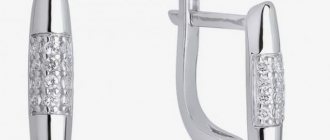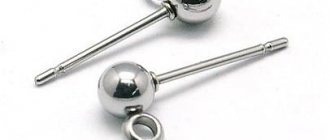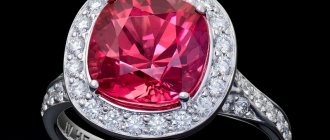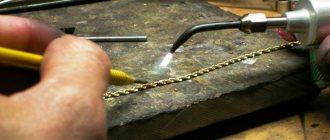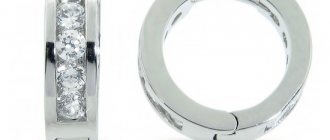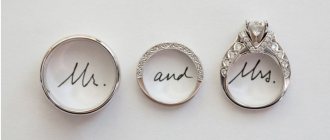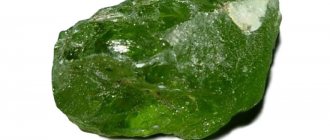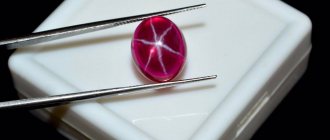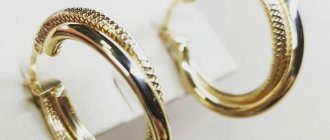The advantages of an English lock on earrings are difficult to overestimate; today it is one of the most reliable fastenings that does not injure the earlobe and almost never requires repair. In addition, you can create any type of jewelry using an English lock clasp (the exception being stud earrings).
But despite the high reliability, many people face a problem. how to unfasten and tighten the English lock on earrings, how to clean the fasteners and adjust them. About everything in the material of our author Elena.
How does an English lock work on earrings?
This is the most common type used in the jewelry industry and is so popular due to its versatility and durability. Clasps are installed on both the lightest and heaviest jewelry, and there is no alternative to them in this segment. To describe the advantages and disadvantages, it should be noted that the clasp consists of three parts: the hook, the flag and the pendant.
According to the production method, English locks can be divided into two categories - cast and stamped. Cast pendants are the most common type, but there may be hidden internal defects that will reduce the service life of such a fastener.
Modern way of ear piercing
For the procedure, special medical earrings made of hypoallergenic alloy are used. They have a pointed end, which makes the procedure easy and virtually painless. The earring is placed in a special device, often called a “gun”. Then, with its help, piercing is carried out, followed by fixing the earring with a lock on the opposite side of the earlobe.
When and how to remove stud earrings? Before removal, some time must pass after the puncture so that the canal can heal completely. This usually takes up to one and a half months.
Types of wires - what to look for
Increasingly, jewelry factories are installing pins made by cutting tinsel. Previously, they were only used in lightweight budget earrings to reduce weight and production costs. Today, such pendants can be found on high-end jewelry. They are very durable and have proven to be very practical and reliable for everyday use.
When choosing earrings, pay special attention to the thickness and width of the metal around the hook hole. This is the weakest point in the entire castle and the one that breaks first.
English castle hook
Crochet is also a very important part of the whole clasp. It can be divided into two types: round wire and rectangular profile.
Round ones are more comfortable for the ear, rectangular ones are more reliable, they do not bend so easily. When purchasing, pay special attention to the thickness of the cut area. Sometimes the cutting edge is too deep and can break quickly.
Problems with the length also often arise: if the earring is too long, it sags; if too short, it squeezes and causes discomfort. The standard distance between body and edge is 7 mm, but deviations of 1 to 2 mm are possible.
Is it possible to remake an English lock on earrings?
Please note that greater length is not an obstacle to purchasing jewelry. In any jewelry workshop it is very easy and quick to make a bar in the right place and charge a small amount of money for it. Changing the size upward is a more troublesome and expensive task. Do not give in to the temptation of the seller and it is better not to make such a purchase.
With an English clasp, the flag is the least of your worries; the main requirement is that it does not interfere with the pendant being opened completely and freely.
Removing earrings
In order to remove earrings from your ears, avoiding injury or infection, you must:
- Stand in front of the mirror;
- Wash your hands using soap or antibacterial product;
- With the thumb and forefinger of one hand you should take the earring by the head (front part), and with the other hand you need to grab the clasp from behind and gently but forcefully pull it to the side;
- If you cannot firmly grasp the lock, you can try to loosen it using nail scissors. The tips of the scissors need to be inserted into the semicircular loops on the back of the clasp and carefully pulled apart. As a result, removing the earring will be easy;
- Treat the earlobes with a gauze swab dipped in hydrogen peroxide. It is not advisable to use cotton wool - if the puncture has not healed completely, small fibers can get into it, causing pain;
- Walk around without earrings for a couple of hours;
- Insert jewelry into your ears (the same studs or new earrings), after treating them with peroxide. This should be done carefully, without pressing the clasp very tightly to the skin;
It is advisable not to remove the product at all for about six months. Later you can choose and change earrings without restrictions.
When deciding to decorate your ears with earrings, you should pay attention to some important details:
- It is preferable to carry out ear piercing in winter - at this time the risk of infection is minimal;
- The first time after piercing the earlobes, you need to treat the wounds daily with a 1% solution of salicylic acid or peroxide before going outside, after returning home, before and after sleep or shower;
- Starting from the second day after the procedure, you should rotate the earrings in your ears with clean hands;
- Until the wounds heal, it is not recommended to sleep on other people’s pillows, touch your earlobes with your hands again, or bathe;
- You should not take off your earrings for a long period. To avoid overgrowth of piercings, it is advisable to insert carnations into the ears for at least a few minutes a day.
This article is provided for informational purposes only and should not be used as a guide to action without prior consultation with a qualified specialist in the relevant field (doctor).
What are shvenzi?
The earring pendants themselves are a metal element that forms a loop through which the jewelry is inserted into the ear. At the bottom of the product there is a special hole into which tags are inserted. In addition, earring pendants often have various prongs into which various gemstones, pearls and other decorative elements are inserted. These prongs may have special prongs for gemstones or, in the absence of prongs, the jewelry is often secured with a thin epoxy resin.
In costume jewelry, pins without locks are most often used, but such accessories are not used for jewelry, since the clasp is not reliable enough and there is a risk of losing the precious piece.
The most correct way to solve the problem
Of course, home experiments can be dangerous and may not have the desired effect. And in cases where you do not understand how to remove stud earrings, you should contact the specialist who pierced your ears. He will quickly and painlessly remove medical earrings and disinfect the canal. It is worth contacting him if inflammation occurs and pus appears.
What does an English lock look like on earrings?
The English castle (Bo hairpin) is one of the most popular designs of this type. It is characterized by a very high degree of reliability and is used in expensive jewelry. A special feature of the English lock is the flat shape of the shank. Due to their width, the earrings will not fit if the ear opening is too narrow.
The French lock has an eyelet at the top in the form of a curved eyelet. It runs down to the base of the blade, where it hooks onto a rim attached to the pivot point.
Italian locking pins are similar to English ones, but in these pins the fastening is adjustable according to the width of the petal.
Studs are simple pins with a base (usually flat). The lock in this type of earrings is a plug that is attached to a pin. It secures the pin with a spacer or is screwed. In the latter case, the pin has a thread.
Hook pendants do not have a closure and are always curved. For safety, some craftsmen put plugs on the hooks (like studs).
Advantages:
- Reliability.
- Convenience.
- Attractive appearance.
- It is extremely rare for the clasp to become bent.
- The ability to close a wide puncture with its elongated design.
- It is impossible to prick yourself with the fastener in a dream.
- Jewelry with such a lock is very difficult to lose.
Flaws:
- There is no possibility of adjusting the clasp.
- Not suitable for a wide lobe (compresses it tightly).
- Designed for people who wear earrings without removing them.
- Many people cannot figure out the technique of using such a fastener.
- If handled incorrectly, the lock can become loose, which will require repairs in a workshop.
- By adjusting the pin yourself, you can cause the product to bend.
Important! If during the use of jewelry your lock has become loose, this does not mean poor quality of the product or a manufacturing defect. This was most likely due to your ignorance of the correct use of the English clasp.
Shapes of clasps for earrings
The wrong type of fastener can cause a lot of inconvenience when wearing. This is why there are so many options: over the centuries since the invention of the very concept of jewelry, people have tirelessly experimented in search of an option that would be comfortable, reliable and beautiful at the same time.
It consists of a pin and a hinge on which a small spring is located. To close the clasp, insert the pin (it has a hole and a small notch) and push it until it clicks.
English castle on earrings
This design has only one advantage: greater reliability. To unfasten such a fastener, you need to slightly pull the hinge up, otherwise it simply cannot be unfastened. To release the clasp, the earring must be gently pulled up, otherwise it will be impossible to remove it. This is why English clasps are used for large designer earrings that would be a shame to lose.
There are two drawbacks: not everyone can easily fasten and unfasten the clasp - this requires some skill and experience. And it is not suitable for everyone, since there is no way to adjust the distance to which the zipper closes. If a girl has a relatively thin earlobe, there will be room for it, and the decorative part will stick out. If the lobe is thick, the pendant will put pressure on it, causing pain.
French clasp for stud earrings
The French version combines the pin and stud into one - the clasp is a small piece of metal that you insert into your ear and then carefully insert into a loop attached to the base.
The advantage is lightness. The clasp does not weigh down the earring, and at the same time it is very easy to put on and take off - just press it lightly. That’s why earrings with it are often bought for children: they don’t fall out, are easy to put on and don’t pull on the ear.
There is also one drawback - fragility. The fragile and thin loop breaks easily under pressure. Therefore, earrings with such a clasp are not recommended to be worn during active activities. It is also recommended to take them off while sleeping.
Italian lock for earrings
It is very similar in design to English, with one exception: there are no serifs on the typeface. Therefore, the pin can be easily inserted and locked in any suitable position.
The advantage of the design is its versatility: earrings with such a clasp are ideal for girls with a non-standard earlobe width, as they are adjustable in position.
There are two drawbacks: you should not sleep in these earrings because the pendant may slip off under pressure. In addition, they are not very reliable - it is better not to wear them during outdoor activities, they can fall off.
What to do if the earring “does not open”?
First, it’s worth figuring out why this happened. If the trouble is caused by an unhealed injury to the lobe after it was pierced, then the secretions accumulated under the lock are to blame. They need to be removed, and then the latch will start working normally. Elimination is carried out through hygienic treatment .
In a caring and disinfectant solution, soak cotton wool and carefully wipe the ear and earring with it. Upon completion of extraction, the processing is repeated. If the problem is caused by other factors, then you need to do the following:
- call someone for help (let another person try to deal with the lock, and if that doesn’t work, then ask him to consider the reason for the jamming of the latch);
- use tweezers (use them carefully, otherwise you will scratch the metal of the jewelry);
- apply a little oil to the latch;
- try opening the lock with a disc soaked in alcohol or oil.
The last option is primarily addressed to those who cannot unfasten an earring with an English clasp. The design of the fixing element involves lifting the pin upward. This is done with the pad of the thumb. If you place a cotton pad between it and the pin, the area of influence on the lock will increase, while reducing the load on the skin and finger.
Important! Manipulations with earrings - removing, putting on - should ideally be carried out only with clean hands. It is also worth taking care of your jewelry and cleaning it regularly. Compliance with these 2 rules will avoid irritation, reduce the likelihood of ear damage and infection from dirty earrings, and also prevent the lock from jamming due to dirt accumulated on its small elements.
If we are talking about an earring that was recently inserted in the salon during or after a piercing, then you need to act differently. Before removal, you should treat the earlobe and earrings, and then try to carefully remove the jewelry. If there is bleeding or you cannot remove the accessory, you should not apply oil or use tweezers. You just need to contact the specialist who performed the puncture. He will figure out the reason for the delayed healing and take adequate measures.
Earrings with English lock
Platforms for attaching jewelry can be solid or with holes. The holes are needed to decorate the product with glass beads or pearls. They are often made in two levels to hide the unattractive rear end.
The lower part of the pendant is often made solid, and the holes are located above or on a special retractable disk. In single-level versions, the back is covered with some decorative element, for example, leather or acrylic.
There are also round pendants that do not have a closure or holes for decoration. Various beads, bobbleheads or something similar are strung on such a base. In such pendants, an additional decorative element is the shape of the central part; it can be a heart, a drop, a flower and much more.
How to unfasten a stud earring correctly?
Sequencing:
- between the fingers of 1 hand, hold the front part of the earring;
- with the other hand, grab the “cork” - the back of the lock;
- extract it.
If we are talking about studs that were installed during a puncture, then you need to thoroughly wash your hands before removing them , and also treat your ear with a caring agent after removal.
Why freeze your bra?
How to find a ring at home if you lost it?
How to remove earrings with an English lock
Women usually have the most problems with an English lock - it is fixed so firmly that it is not immediately clear how to remove it. Usually proceed with caution:
- Hold the pin between your fingers to prevent it from moving.
- Gently grasp the pin with your other hand and pull it up.
- When it moves slightly, pull it towards you.
- It is important to catch the moment when the pendant slips out of the groove and not pull it up until that moment.
If simple pulling does not help, it is recommended to slightly rock it from side to side.
The most important thing is not to damage your ear in the process, don’t get upset and don’t rush - and learning how to open an English lock on earrings won’t be that difficult.
Unfasten the loop earring
There are 2 types of loop earrings . One is not fixed in any way at the opposite end; it is held on the ear due to the long length of the earpiece and a slight rounding on it (may be absent). The second has the tip threaded into the hook.
The first option is easy to remove . You need to pull the lobe down a little and remove the jewelry from it. In this case, sudden movements should be avoided, since the elongated wire can damage the ear from a jerk.
The loop earring with hook is removed differently:
- the thumb is placed on the back of the loop, and the index finger on the front;
- the earring is slightly compressed (because of this, the gap between the walls of the loop is reduced);
- use the fingertip of the second hand to lower the hook down;
- remove the jewelry from the earlobe in the same way as in the case of a regular loop earring.
Important! When you squeeze the jewelry, do not apply much force, otherwise the accessory will deform very quickly.
French or English lock on earrings - which is better?
There are two types of fasteners that can officially be considered the most reliable:
English castle. The pendant is securely fixed in its groove; it does not move or become loose. It is almost impossible to lose such an earring unless it breaks. It requires some effort to destroy it. The English lock is so secure that novice users often have difficulty unfastening it.
Pusset screws. It is much easier to put on than the English version, but the principle is the same: the pendant is screwed onto a pin and firmly fixed in it. To remove the earring, you need to unscrew it, and this can only be done by hand. Such a clasp is difficult to break, and it is almost impossible to lose the earring.
All other earring clasps are not so reliable, although they can also be very convenient. Therefore, an English lock on earrings is preferable to a French one, which is fragile and easy to open.
What do you need to know to make wearing earrings a joy?
The question of how to remove stud earrings for the first time worries many. But this is only the beginning of the “relationship” with these jewelry. To prevent the channel from becoming overgrown and the need for repeated piercing, you need to wear earrings constantly for the first six months. Even when a lot of time has passed after the procedure, it is recommended to wear earrings regularly, at least half an hour a day.
The best choice would be a gold or silver pair. These metals are considered safe and even medicinal. Further choice should be based on the safety of the metal, so you should stay away from cheap jewelry of dubious production.
Each change of earrings should be accompanied by pre-washing of hands and treating them with alcohol.
A difficult problem that many mothers face is how to remove stud earrings from small children. It is best to do this in the salon where the ears were pierced. If the child is spinning and does not allow his ears to be touched, you should try to do this at home while the baby is sleeping.
English castle - how to choose the best
It will be easier to determine this if we understand well what shwenza is. As we already know, this is an important element in jewelry making. Before purchasing, unfasten and close the locks and evaluate their strength. Compare the two studs to each other. Look carefully at the color of the metal and its uniformity. Do not forget that the surface must be flat and smooth.
